Introducing the Newly Opened Path in the Sacred Area of Largo Argentina
by Adriana ruiz
Since June 20, the Sacred Area of Largo Argentina has opened to the public with a new route that allows access to the site for the first time and enables systematic visits, providing insights into its different phases of life from the Republican era through the imperial and medieval periods until its rediscovery in the last century during the demolitions of the 1920s. The works, conducted under the scientific direction of the Capitoline Superintendency of Cultural Heritage, were made possible thanks to an act of patronage by Bulgari.
The grandeur of the remains of the temples in the Sacred Area can now be appreciated up close, allowing visitors to admire the details, construction phases, and materials at the same level as the structures that citizens and tourists have observed from street level for decades.
The works were carried out with attention to criteria that made the site easily accessible to all. From Via di San Nicola de’ Cesarini, visitors have the opportunity to descend and visit the archaeological area through a barrier-free walkway. An elevator platform allows access for people with reduced mobility, while all level differences and height variations have been eliminated inside, making the visit comfortable even for wheelchair users or those with strollers.
“The limited and targeted investment that involved the Largo Argentina area gives Romans and tourists the opportunity to enjoy one of the most beautiful sites in the world,” commented Mayor Roberto Gualtieri. “It will be possible to follow the events of this extraordinary area of Republican Rome, which houses treasures such as the four temples, the pavement commissioned by Emperor Domitian, and the wall of the Curia of Pompey where Julius Caesar was assassinated. Moreover, the entire site has been made fully accessible, with particular attention to the inclusion of people with reduced mobility and visually impaired individuals. I thank Bulgari for its act of patronage and for the strategic and structural choice to allocate resources to this site that has not been fully experienced for decades. Full accessibility is truly an added value for this area.”
“Citizens of Rome and tourists will now be able to see up close marvelous archaeological artifacts from various eras of our city’s history,” said Miguel Gotor, Councilor for Culture of Rome Capital.
Jean-Christophe Babin, CEO of Bulgari Group, expressed his pride in having contributed to finally making this archaeological and architectural gem accessible to citizens and tourists, highlighting its value as a precious testimony to the fascinating overlay of eras and styles that makes the Eternal City unique in the world. “This project has allowed us, once again, to honor the deep bond we have with Rome, an inexhaustible source of inspiration and a millennial crossroads of arts, cultures, and traditions. In the Sacred Area, one can feel the breath of history. These majestic remains tell the greatness of an empire that has shaped our civilization.”
“The precious work of the technicians from the Superintendency,” explained Superintendent Claudio Parisi Presicce, “has restored to the city an extremely important area, allowing everyone to admire a slice of history spanning over two millennia: from Republican Rome to the era of emperors, from the reuse of structures as dwellings for aristocratic families, churches, and monasteries, to the demolitions of the 1920s. The splendid result that can be seen from today is thanks to a fruitful collaboration between public and private sectors, for which I want to thank the Bulgari Group.”
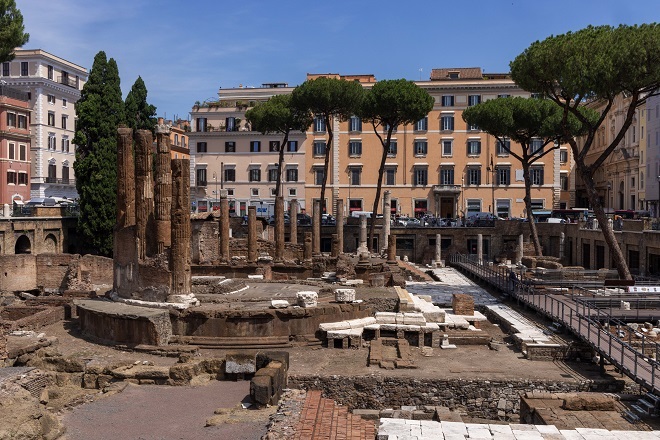
New Features
A significant novelty is represented by the two exhibition areas: one in the medieval portico of Torre del Papito and the other in the premises beneath the street level of Via di San Nicola de’ Cesarini. These spaces have been set up with a selection of numerous artifacts from excavations and demolitions carried out in the last century. Among them are fragments of inscriptions, sarcophagi, architectural decorations, and two colossal statue heads belonging to revered deities in the area.
To better tell the story of the site and the transformations that have taken place over the centuries, the entire visitor route is equipped with a series of informative panels in Italian and English, accompanied by a rich photographic collection.
For the visually impaired and blind individuals, two large tactile panels have been created in Italian, English, and Braille, providing information about the entire complex and individual monuments. These panels include tactile representations of two scanned 3D artifacts—a fragment of a slab depicting a bird pecking at fruit and the colossal head of a female cult statue.
New lighting has been installed along the walkway and in the exhibition spaces, while the portico of Torre del Papito at street level has also been illuminated.
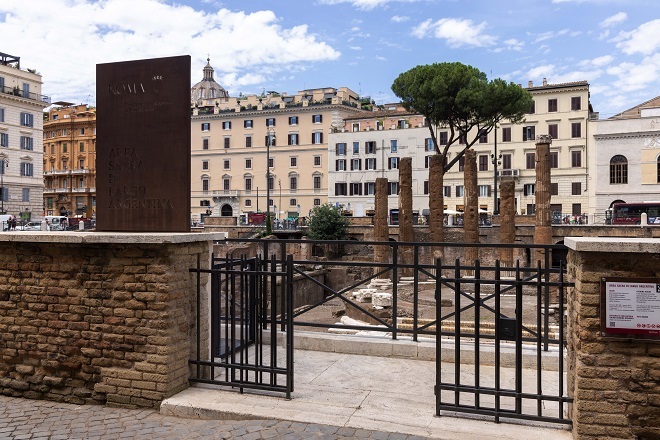
Historical Background
Between 1926 and 1929, the demolition work carried out in the quarter between Via del Teatro Argentina, Via Florida, Via S. Nicola de’ Cesarini, and Corso Vittorio Emanuele II for the construction of new buildings uncovered a vast paved square on which four temples are located. These temples are commonly referred to by the first four letters of the alphabet due to the absence of certain identification: Temple C (early 3rd century BC), probably dedicated to Feronia; Temple A (mid-3rd century BC) in honor of Giuturna; Temple D (early 2nd century BC), dedicated to the Nymphs or Lari Permarini; and Temple B (late 2nd century BC), dedicated to Fortuna Huiusce Diei.
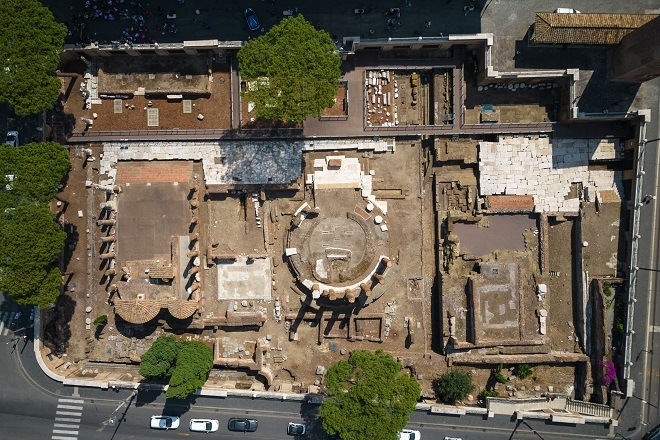
In the mid-1st century BC, the Portico of Pompey complex was built adjacent to the sacred area, with the Curia (of which the tuff foundation is still visible behind Temples B and C) being the site of Julius Caesar’s assassination.
The fire of AD 80, which devastated a large part of the Campo Marzio, led to a profound transformation of the area under Emperor Domitian, including the construction of a new travertine pavement that is still visible and the reconstruction of the temple facades.
The process of abandonment and transformation of the buildings began in the 5th century. It is believed that the area was occupied by a monastery complex, and later, between the 8th and 9th centuries, structures were built, possibly belonging to aristocratic houses. The first evidence of a church inside Temple A dates back to the 9th century, which was dedicated to St. Nicholas in 1132 and initially known as “de’ Calcarario” and later “de’ Cesarini.” In the Baroque period, a new sacred building was erected on the medieval church, which was completely destroyed during the demolitions by the Governorate.
Don’t forget to check out our Social Media accounts and Newsletter so you can join us in the next Social Meet-ups for Expats! We hope to see you at Meetup soon!

Single Female Travelers in Italy: Practical, confident, and connected
Rome rewards curiosity and courage. This guide offers grounded tips, cultural insight, and community support so you can explore with confidence—day and night, solo and on your own terms. Start with confidence “Solo doesn’t mean alone.” In Rome, you’ll find friendly locals, layered history, and a vibrant expat network. A little preparation goes a long […]
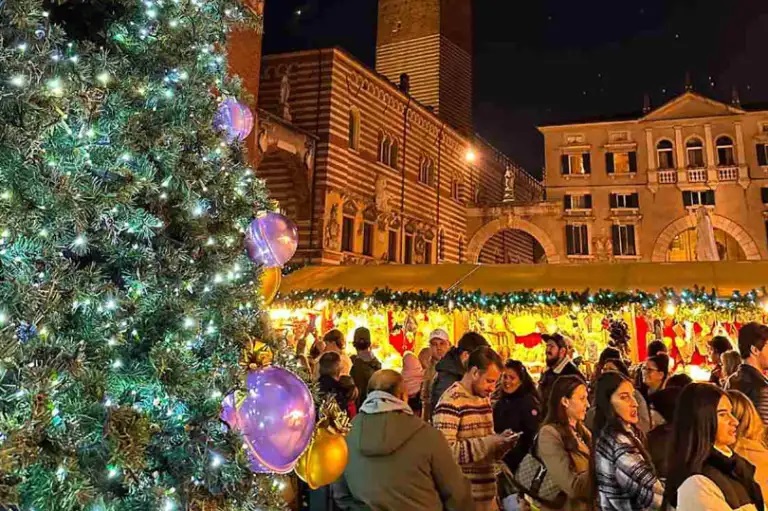
Christmas in Italy 2025: A Magical Season for Expats Across Italy
Christmas in Italy isn’t just a holiday — it’s a season full of history, flavor, celebration, and heartfelt traditions that bring families, towns, and entire regions to life. Whether you’re an expat experiencing your first Italian Christmas or a returning fan of the magic, 2025 promises some beautiful celebrations across the country. Here’s what to […]

Tax Residency Incentives in Italy — Your Guide (2025)
Italy offers several tax incentives designed to attract retirees, entrepreneurs, high-net-worth individuals and remote workers. These regimes can be extremely generous — but they are complex and often conditional. This guide explains the main options in 2025, who qualifies, and how we can help you plan a compliant move. Why Italy Offers Tax Incentives Italy […]

Navigating Healthcare in Rome: A Guide for Expats with English-Speaking Doctors
Moving abroad is exciting, that is until real life hits. I came to Italy from Alaska in 2021 for what was supposed to be a four-month study program in Florence. Four years later, I’m still here, now living and working in Rome. When we plan our dolce vita, we think about pasta, museums filled […]

Major Tax Incentives for Home Renovation in Italy (2024-2033)
Taxpayers carrying out renovation work on residential buildings and common areas of residential complexes in Italy are entitled to claim significant tax relief. This benefit allows individuals to deduct a portion of the expenses incurred from their Italian personal income tax (Irpef). This article outlines the rules, beneficiaries, and changing deduction rates for these home […]
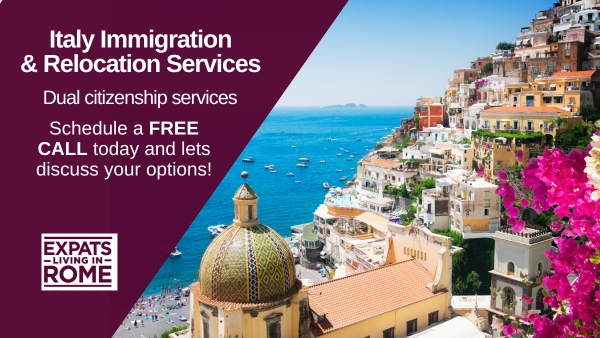







Leave a Comment:
You must be logged in to post a comment.